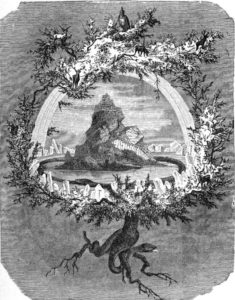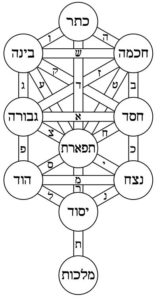As we approach Christmas and New Year’s Eve and start seeing “Christmas trees” popping up all around us, it is worth exploring where this custom came from, and what the Torah might say about it. It is especially important to address because some Jews from the former Soviet Union continue to have a (seemingly) non-religious “New Year’s tree” yolka in their homes, as do assimilated and intermarried Jews across Europe and America. Is it okay to have such a tree in a Jewish home? As might be expected, the short answer is “no”. To properly understand why, we must take an eye-opening trip back in time.

An 1886 illustration of Yggdrasil by Friedrich Wilhelm Heine
The ancient Nordic and Germanic tribes celebrated a winter solstice festival usually referred to as Yule. Part of the ritual involved worshipping and decorating an evergreen tree, which symbolized life in the dead of winter. Many tribes associated the tree with Odin, the “father of all the gods” in Norse mythology. He was the most powerful figure in the Nine Worlds, represented by Yggdrasil, the sacred tree. Yggdrasil was a “tree of life” of sorts, while beneath its roots lay Hel, the underworld of the dead, and the origin of the English word “hell”. The word Yggdrasil itself means “Odin’s horse” or “Odin’s gallows” (Ygg, or Yggr, is another name for Odin). Others associated the tree with another powerful deity, Thor, “god of thunder”, Odin’s son and protector of Earth. (Fun fact: Wednesday and Thursday are named after Odin and Thor, ie. Odin’s-day and Thor’s-day!)
In 723 CE, the Christian missionary Boniface went forth to convert the pagan Germanic tribes. He came upon a village in the midst of worshipping an oak tree in honour of Thor and were apparently about to sacrifice a baby. Boniface took an axe and chopped the tree down—according to legend, miraculously in one swipe. He didn’t do away with the tree-worshipping ritual entirely, though, and offered the pagans a way to hold on to their old customs: Boniface pointed to a baby fir tree and said “let this tree be the symbol of the true God”. So goes the story, anyways.
While the Germanic and Nordic tribes were all eventually converted to Christianity (some by choice, most by force), they retained many of their old customs. Another example: In Norse myth, “Father Odin” (with his long white beard) would go around on his eight-legged horse to deliver gifts at Yule-time, with the help of the alfar, “elves”, which play an important role in the Norse worldview. “Father Odin” became “Father Christmas”, ie. Santa Claus. To make this less pagan and more palatable to Christians, the figure of Santa Claus was eventually associated with “St. Nicholas” instead, much like the pagan evergreens became symbolic of the Tree of Life in the Garden of Eden. In fact, the spherical red ornaments commonly hung on Christmas trees evolved from apples once hung on Christmas trees to represent the Forbidden Fruit.
There is a great deal of irony here, in that something symbolizing life is chopped down and killed! (And plastic tree alternatives are no better, for they will go on to contaminate the Earth with toxic chemicals for centuries.) It is fitting, then, that the Christmas tree is decorated with “apples” of the Forbidden Fruit, which did not grow on the Tree of Life, but rather on the Tree of Knowledge which brought death into the world. Rabbi Abraham Abulafia (c. 1240-1291), one of the great Sephardic mystics, in his Sefer Sitrei Torah, likened the wooden cross upon which Jesus presumably died to the Tree of Knowledge. (In Hebrew, the word for “wood” and the word for “tree” is the same, etz.) Jesus claimed to be the Tree of Life, the only path to eternal life in Heaven, and for this preposterous claim—supplanting the singular God and His Torah—he was punished measure for measure by being killed on a “tree of death”.
Abulafia held that believing in Jesus was undoubtedly a form of idolatry (and, for those who like numbers, he gave a further mathematical proof in that the gematria of “Jesus”, Yeshu [ישו] is 316, equal to “elohei nekhar”, אלהי נכר, the Torah term for a foreign or false god). We should remember to stick to the one true God and His Torah alone for, as King Solomon said, “it is a Tree of Life for those who grasp it, and whoever upholds it is fortunate.” (Proverbs 3:18) In case anyone was doubting what Solomon was referring to here, he began by stating Torati al tishkach, “do not forget My Torah, and may My mitzvot always be upon your heart.” (Proverbs 3:1) The Torah, and fulfilment of its mitzvot, alone holds the true spiritual path—that is the Tree of Life.
One of those 613 mitzvot of the Torah is not to worship trees, nor bring trees anywhere near the sacrificial altar in the Temple, not even to plant trees that might later be used for worship (Deuteronomy 16:21). Throughout the rest of Scripture, we find that Jews unfortunately sometimes went astray and succumbed to the idolatries of the nations around them, including worshipping Asherah trees and using them as ritual objects. The prophet Jeremiah warned us long ago: “Thus said God: Do not learn from the ways of the nations… for their customs are worthless; they chop down a tree from a forest, they adorn it with silver and gold…” (Jeremiah 10:2-4) As such, there is certainly no room for Christmas trees in a Jewish home. But what if the trees are devoid of any religious significance?
Yolka
After the October Revolution of 1917, the Communists in Russia went on to ban all religious activity, including Christmas trees. Nonetheless, as the famous saying goes, “old habits die hard”, and people weren’t willing to give up on their customs. Thus, just as Boniface had done centuries earlier, the leaders of the USSR decided to simply replace the symbolism. In 1935, they reintroduced the ritual as a novogodniya yolka, a “New Year’s tree”, along with Dyed Moroz, “Grandpa Frost”, and his snowy female helper Snigurachka, in place of the more religious Santa Claus and his mystical elves. Instead of Christmas Eve, Dyed Moroz would come on New Year’s Eve. (Interestingly, the mysterious word yolka probably comes from that pagan Yule festival.)
In the past, we’ve written about the permissibility of Jews celebrating the secular New Year’s Eve. While there is some leniency regarding New Year’s Eve, the tree in the home is an entirely different issue. When the Torah is so explicit about avoiding any tree rituals, and considering how strongly the Tanakh cautions us about Jews going astray and mimicking the tree-customs of the nations, and keeping in mind how the origins of the tree are deeply pagan first and foremost, as well as extensively Christian thereafter, it is important to stay away from anything remotely resembling a Christmas tree or yolka.
Thankfully, we have a much better tree-related celebration just a month or so after in Tu b’Shevat. This one requires no wanton destruction of trees, nor any pagan-like tree rituals, instead simply appreciating all the good that trees and plants do for us. And it comes with a mystical custom to hold a Tu b’Shevat seder, like on Pesach, symbolizing the forthcoming Final Redemption. When the actual Mashiach does come to usher in the Redemption, our Sages say he will “flourish like a palm tree; thrive like a cedar in the Lebanon.” (Psalm 92:13) May we merit to greet him soon.


